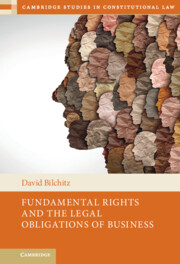Book contents
- Fundamental Rights and the Legal Obligations of Business
- Cambridge Studies in Constitutional Law
- Fundamental Rights and the Legal Obligations of Business
- Copyright page
- Dedication
- Contents
- Figures
- Tables
- Preface
- Acknowledgements
- Table of Cases
- Introduction The Question of Substantive Corporate Obligations for Fundamental Rights
- 1 The Nature and Purpose of the Corporation in Law
- Part I Legal Doctrinal Models for Addressing the Substantive Obligations of Non-State Actors for Fundamental Rights
- Part II Towards a Multi-Factoral Approach for Determining the Substantive Content of Corporate Obligations
- 6 The Justification for and Contours of a Multi-Factoral Approach
- 7 A Balancing Act – Proportionality in the Corporate Sphere
- 8 The Multi-Factoral Approach and Positive Obligations for Corporations
- Part III The Institutional Implications of the Multi-Factoral Approach
- Bibliography
- Index
6 - The Justification for and Contours of a Multi-Factoral Approach
from Part II - Towards a Multi-Factoral Approach for Determining the Substantive Content of Corporate Obligations
Published online by Cambridge University Press: 29 October 2021
- Fundamental Rights and the Legal Obligations of Business
- Cambridge Studies in Constitutional Law
- Fundamental Rights and the Legal Obligations of Business
- Copyright page
- Dedication
- Contents
- Figures
- Tables
- Preface
- Acknowledgements
- Table of Cases
- Introduction The Question of Substantive Corporate Obligations for Fundamental Rights
- 1 The Nature and Purpose of the Corporation in Law
- Part I Legal Doctrinal Models for Addressing the Substantive Obligations of Non-State Actors for Fundamental Rights
- Part II Towards a Multi-Factoral Approach for Determining the Substantive Content of Corporate Obligations
- 6 The Justification for and Contours of a Multi-Factoral Approach
- 7 A Balancing Act – Proportionality in the Corporate Sphere
- 8 The Multi-Factoral Approach and Positive Obligations for Corporations
- Part III The Institutional Implications of the Multi-Factoral Approach
- Bibliography
- Index
Summary
The analysis in the last chapters reveals a convergence across the various models and jurisdictions considered in addressing the ‘substantive content’ of the obligations of non-state actors. This chapter attempts to describe and systematise what emerges from these judgments into an analytical framework which I term the ‘multi-factoral approach’. An optimal articulation of this approach, I argue, requires a series of steps, three of which I seek to accomplish in this chapter: namely, identifying the various factors at play in a situation; examining their normative grounding and understanding their relevance to the imposition of corporate obligations; and, developing presumptive principles, that help us understand their implications for corporate obligations. I identify and explore the relevance and weight to be accorded to three beneficiary-orientated factors (interests, vulnerability and impact) as well as three agent-relative factors (capacity, function and autonomy). This chapter also shows that none of these factors is alone sufficient to determine corporate obligations.
Keywords
- Type
- Chapter
- Information
- Fundamental Rights and the Legal Obligations of Business , pp. 219 - 263Publisher: Cambridge University PressPrint publication year: 2021

